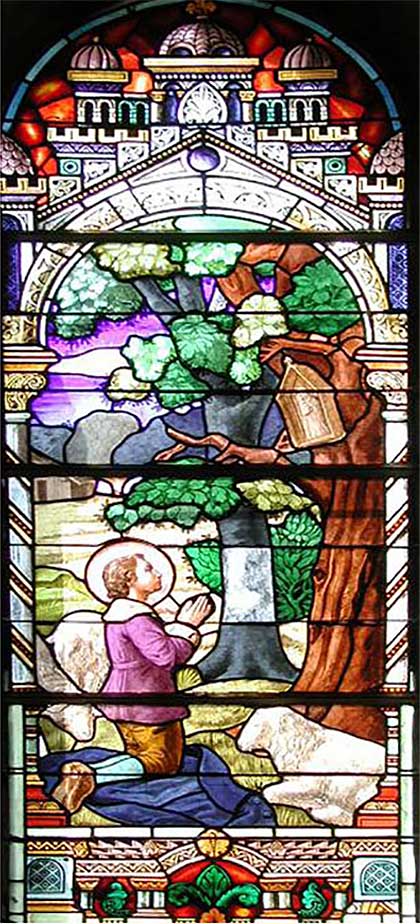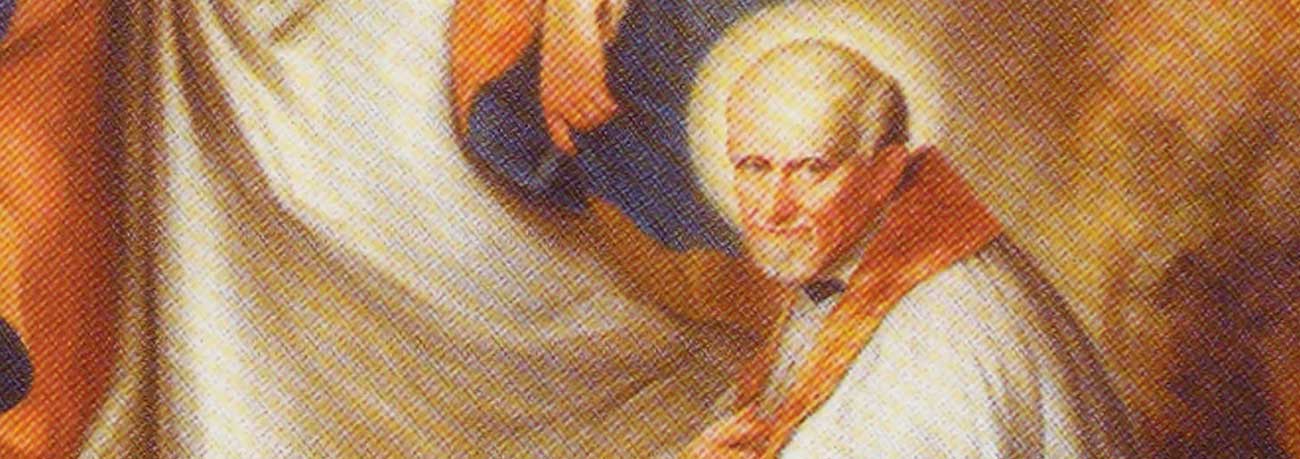Saint Vincent’s Devotion to Mary
Saint Vincent's Devotion to Mary
By Kieran Moran, CM
Reprinted from the July 1929, Miraculous Medal magazine

We are so much dazzled by the splendor of Saint Vincent’s charity for the neighbor that we may be inclined to neglect his other virtues. We are so engrossed with his achievements for his fellowman that we may be tempted to forget what he did for himself. It is well to realize that before he presumed to sanctify others, he devoted great care to sanctify himself. And among the virtues that helped him to this end, a prominent place must be given to his devotion to our Blessed Lady.
At his mother’s knee he first learned the story of Mary’s dignity and power. What a thorough lesson it was! And how amazingly grasped! From that lesson the practical boy went forth to place in the hollow of a huge oak tree his first tribute to his Queen: a little statue made by himself in her honor. Before it he dreamed his dreams and said his prayers.
From it he wandered to his other favored spot, the venerated chapel of Our Lady of Buglose. Formerly it bad been a beloved shrine for the pilgrims of Southern France; now it was desecrated and in ruins because of the religious wars of the times. Amid those ruins he pleaded with his heavenly advocate to keep ruin from his soul always. There, his love for her increased through his efforts to make reparation to her for the destruction of her sanctuary and the profanation of her image. It was a place whose every scattered stone spoke to him of Mary, of Mary rejected by her own children; of Mary whom even then he resolved to restore to her rightful throne in the esteem of men. There, we believe, was born that zeal for her honor that afterwards impelled him to preach so eloquently of her glory and to lead vast multitudes of his bearers to practice her virtues. There, surely, his Immaculate Queen gave him his undying love for chastity, his unshakeable resolve to safeguard it in himself forever, to nurture it in the innocent, to restore it to the unfortunate.
After such a childhood, he did not find it difficult during the years of his studies to stay close to the Seat of Wisdom. She kept him safe from the fierce moral dangers of those turbulent times. Under her tutelage he penetrated so deeply into the principles of faith that in later years when subtle Jansenism was deceiving the minds even of those in high places, he was able to see and refute its fallacies.
We need not be told, then, that when the powers of the priesthood were his, he chose for the celebration of his first holy Mass the chapel of Our Lady of Grace. With him were but two visible persons: the assistant and the server. All others he excluded so that he might give his undivided attention to that mighty Act whereby “the Word made Flesh” again “dwells among us,” and whereby Vincent became so like unto Mary herself. “O wonderful dignity of the priest in whose hands, as in the womb of Mary, the Word of God becomes Incarnate!” The young priest was glad, because it was Bethlehem again, with its isolation, its poverty, its obscurity, its uncrowded silence. He was glad, because he was unhurried in the solemn renewal of his great sacerdotal vows to the Most High God through the hands of his Immaculate Mother.
During his priestly career Mary was more than ever “his life, his sweetness, his hope.” His steadily growing love for her strengthened and sanctified his soul. Under her guidance he advanced in wisdom and in grace before God and men. His interior, personal holiness, so profoundly influenced by Mary, expressed itself in actions that manifested his overwhelming devotion towards her; and that devotion pervaded and colored all his tremendous activity for the salvation of souls.
There was scarcely a sermon, a conference, an exhortation that did not glorify Mary. He brought her into the galleys and the prisons, a vision of relief for the most hopeless of men. With him she went into the hovels and hospitals, an angel of mercy to suggest and inspire remedy and cure. And she gave to this strong, rugged man, a man naturally inclined to ·be rough and stern, the heart of a mother for all the afflicted. As his latest biographer says: “His devotion to the Mother of Our Lord resulted in the feminizing—I use the word in its highest and strictest sense—of his virile charity and added to it that exquisite sweetness, that understanding of the maternal, that marked its spirit.”
Moreover, Vincent deeply and firmly impressed his great love for Mary on the soul of his two communities, the Priests of the Mission and the Daughters of Charity. He gave them the mandate to venerate her in her Immaculate Conception, anticipating by two hundred years the solemn definition of Pius IX. He gave special rules about her rosary and her feasts, explaining in detail the means by which his consecrated children should pay constant tribute to her. His sons in their own interior lives and in their ministrations to others have not forgotten the behests of their Blessed Father in God.
His daughters, the Sisters of Charity, took so much to heart the burning instructions of Saint Vincent and carried them out so faithfully that their community became, and is, singularly beloved by Mary. She saw, and sees, it as a carefully nurtured garden of lilies, suggesting and proclaiming to men her own stainless glory. As if in gratitude, and surely as a sign of signal approval, Mary selected this community of Sisters to be the favored recipient of one of her greatest manifestations of power since Gospel days. For to a Daughter of Charity, Sister Catherine Labouré, the Blessed Virgin revealed her Miraculous Medal, and willed to have that favor prefaced by the apparition of Saint Vincent himself, as if to show the relation between him and her marvelous gift. How profound, how sincere, was Vincent’s devotion to Mary, to have produced such a wondrous effect in one of the obscurest of his children after the lapse of two centuries!
May Vincent de Paul obtain for all of us a consuming love for Mary, like unto his own, so that, like him, we may walk always with her, gather others to her service, and have her Mother’s love pleading for us at the end.
Image Attributions
Banner
8542 SVdP with Mary
Used with permission, vincentianpersons.cdm.depaul.edu
Inset
2739 SVdP before the oak tree
Used with permission, vincentianpersons.cdm.depaul.edu
Get InSPIREd!
Sign up below and receive our monthly inspirational Newsletter dedicated to Mary!


